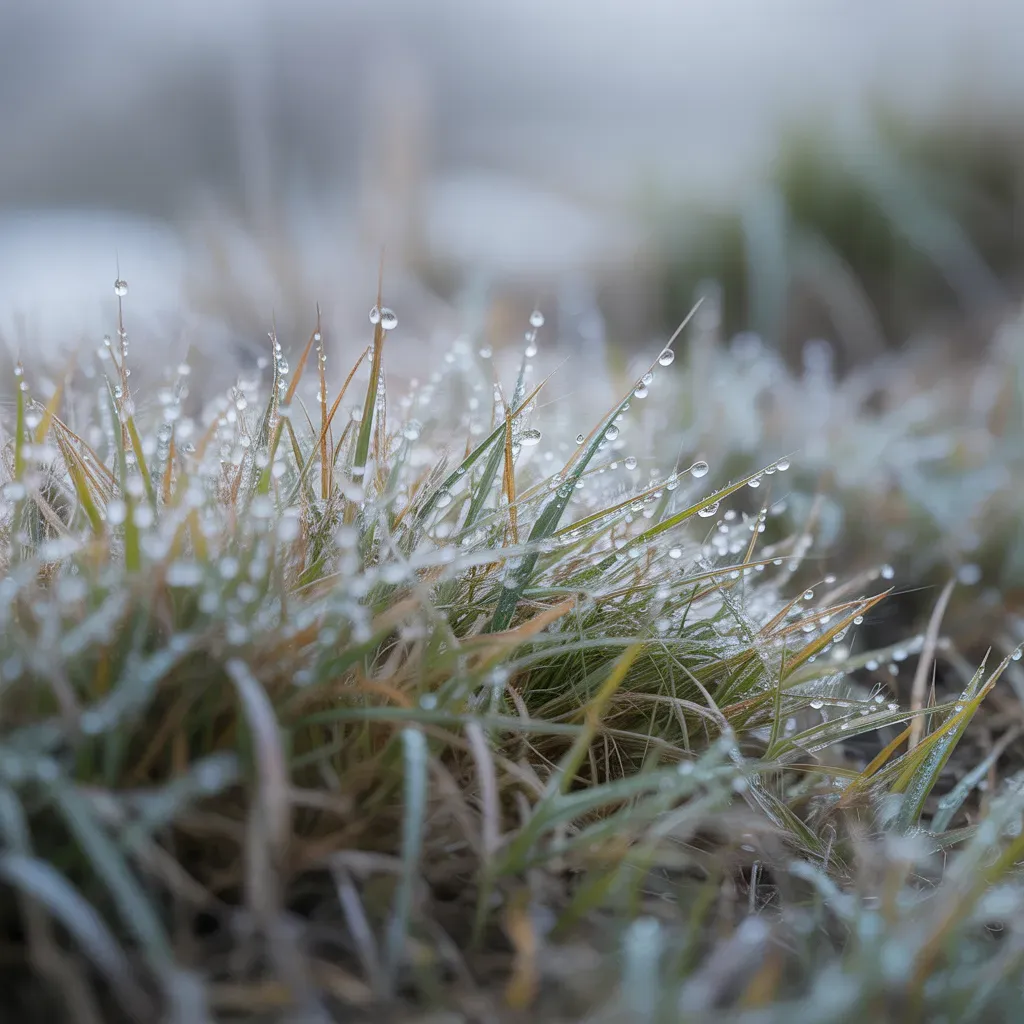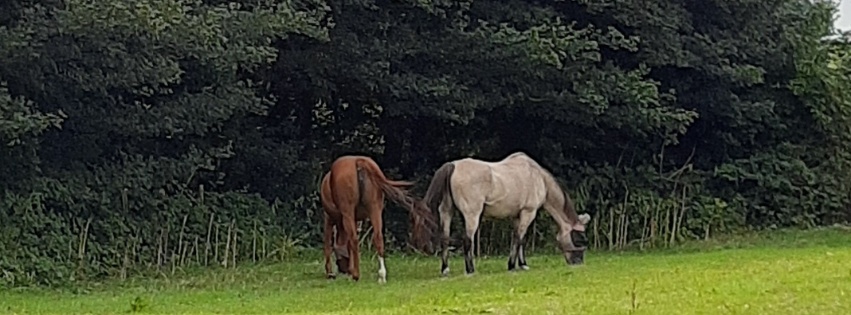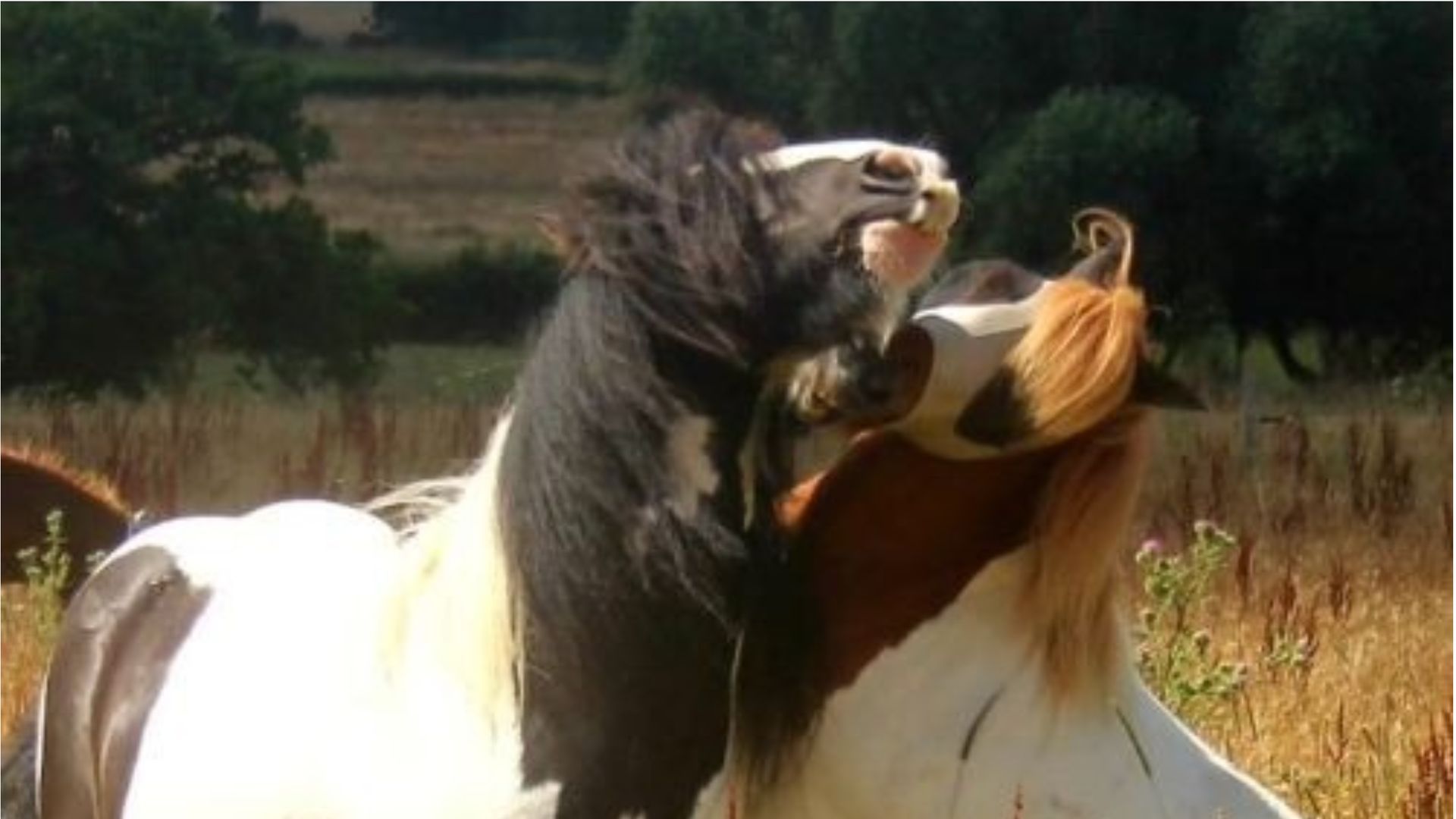Connecting Bone and Gut Health
- Continuing the importance of feeding appropriate prebiotics
(See our previous Blog Prebiotics for Postbiotic Abundance)
Image - EquiNatural's Carmen, 10-months after we adopted her, aged 7.
Caring for our TB mare, Carmen, has been a special project for me since we took her on in 2014.
Carms came to us as a 7yo with an inward-twisting LF hoof and pastern from birth, with a vet label pronouncing her 2/10 lame, although I’m sure she’d prefer to disagree as no-one field-hoons quite like Carms.
She was discarded to life as a brood mare, until by the age of 6 she'd been passed from home to home, and was found by her former owner abandoned in a field when they were looking at another horse for their daughter. They didn't buy said horse, but saw the whip scars on Carmen's rump and how she hobbled, and took her home there and then on an alleged rescue mission.
Thing is, there’s rescue and there’s rescue. Sadly, when I met her a year later she was isolated in a field with no buddies nearby, on a permanent script of pain-meds and annual steroid jabs. Her hooves hadn't seen a rasp for months - they were all overgrown and dished with very poor quality hoof capsules, eached scarred with lami event lines and underrun heels. She was also on a feedbowl regime of high-molassed, 17% sugar chaff (you know the brand) and cheapo grass nuts containing all the ingredients I avoid like the plague. She looked sad, undernourished, and lonely, despite the owner bigging herself up as having done a good deed.
She then said she was planning on selling her on for £500, because being an overindulged daughter of rich parents, she could no longer be bothered with her. That was it for me ... and yes, as if you need to ask, Carms came to live with us literally the next day, and so began her new life, starting with a major detox and diet change. Several years on? She’s our sassy, gleaming,16yo herd boss, sensitive and soft to cuddle yet oh-so intelligent, and one thing’s for sure – if you mess with her you’ll know it! Oh, and needless to say she does not get those annual steroid jabs 😉.
However, because of her limb distortion, arthritis for Carms is pretty much a given, and we’ve had numerous blips when a field hoon (which she’s very good at, and very fast!) has rendered her a bit 3-legged. But overall it's very obvious as to how the rest of her skeletal frame compensates for her LF; she transfers weight to her right side to relieve the pressure on her left, so her RF takes all the strain, hence why she throws a major flare between each trim for balance, and her RF pastern is noticeably more dropped. Despite this, her bodyworker reports that all things considering, she’s a calm and happy mare, and in pretty good shape 😉.
All this means that I’m permanently on it for her, and always swatting all-things-osteo to keep her mechanicals as comfy as I can. And being a studious student of Functional Medicine, I’ve recently attended an IFM seminar about the connection between bone health and the gut, so naturally I thought I’d share with you all, as I know many of you have older horses with all kinds of arthritis, never mind us too! Kind of comes with the cold, damp, wintry territory over decades of shovelling sh1t and having a deeper relationship with a wheelbarrow than with our patient OH’s.
Connecting Bone and Gut Health
The skeleton is a metabolically active organ that undergoes continuous remodelling throughout life. This is where osteoclasts and osteoblasts come into the great scheme of things - osteoclasts are responsible for aged bone resorption (the removal of mineralised bone) and osteoblasts follow this with the responsibility for laying down new bone formation.
Known as the ‘bone remodeling cycle’, it’s a vital part of the body’s natural systemic regulation processes. It adjusts bone architecture when skeletal mechanical needs require it, helping to repair microdamages in the bone matrix to prevent the accumulation of old bone, and it also plays an important role in maintaining plasma calcium homeostasis. Multiple hormones are involved, most notably PTH, the parathyroid hormone, as well as growth factors and proteins, all working together to maintain skeletal integrity.
And our old friend, the gut microbiome, is very much involved as well, because the various tissues of the skeletal system are intricately connected to the health of multiple body systems, including the GI tract and the gut microbiome. Bone-related disorders such as osteoarthritis have been associated with dysbiosis in the gut microbiota, while an increased prevalence and development risk of low bone mineral density has been associated with gut disruption/intestinal inflammation.
These days we know that a healthy intestinal microbiome completely influences what goes on in the body, everything from nutrient absorption and metabolite synthesis to immunomodulation, and now there are also studies showing that it also affects bone homeostasis; if the bone remodelling cycle is out of kilter, with resorption rates outpacing new formation, it’s now thought that an impaired gut may be involved.
Knowing that a healthy fibre intake and a variety of prebiotic foods support gut balance and maintain the beneficial microbiota colonies, research investigations continue to reveal the connection between the mechanisms of the gut microbiota and bone cell communications. They also show that the microbial landscape impacts nutrient absorption and metabolism, with some commensal bacteria believed to promote the intake of bone-related minerals such as calcium, magnesium, and phosphorous.
Gut Microbiome Impact on Bone
If you regularly read our blogs you’ll have seen me recently posting about the hindgut microbes’ fermentation process producing numerous, and vital, bioactive compounds – metabolites/postbiotics (provided we feed the gut right, that is 😉) - that are also important for bone health, including B vitamins and vitamin K.
One critical area of beneficial hindgut postbiotic production are short-chain fatty acids (SCFAs) which play a regulatory role in osteocyte metabolism and bone mass. Furthermore, an abundant SCFA, butyrate, is believed to promote osteoblast diversity and stimulate mineralised nodule formation to support bone growth. And a recent animal study found that butyrate was required for the important parathyroid hormone (PTH) to stimulate bone formation and increase bone mass. Research also suggests that gut-derived hormones also play an important role in bone homeostasis and metabolism (see numerous source data below).
Interestingly, the use of pro-biotics to support healthy bones has shown some conflicting results depending on dosage and species, where a recent review and meta-analysis evaluated the probiotic consumption effects on bone health from 44 studies, and before you ask, 37 were animal models. Researchers found that in clinical trials, probiotic consumption negatively affected bone health parameters such as serum calcium levels, urinary calcium levels, and PTH levels.
This continues to suggest that maybe there’s no guarantee that feeding a probiotic supplement will establish the species-appropriate microbe colonies in the biome, endorsing the new thinking that it’s more about feeding the existing beneficial colonies more ‘probiotically’ via prebiotic foods. For our horses the thinking is clearly heading more towards the fact that by feeding appropriate prebiotic fibres to our horse (cellulose/hemi-cellulose fibre from stemmy hay), there may be no need to feed a probiotic.
As for us humans? It’s the good old mediterranean diet, which is a well-studied example that's been evaluated on numerous occasions specific to its impact on bone health. Just this year (2022) a systematic review and meta-analysis (eight observational studies with 13,209 participants) investigated the relationship between the mediterranean diet and bone mineral density values in adults, indicating small but statistically significant increases in bone mass density in the whole body, but especially at the lumbar spine, neck and hip, which for us horse folk with knackered lower backs is no bad thing!
Specifically, inulin-type fructans (prebiotics) were found to promote an abundance of beneficial human biome bacteria colonies, and had a range of beneficial health effects from improved intestinal barrier function to increased absorption of the bone-related nutrients calcium and magnesium. So that'll be chicory and jerusalem artichoke on the shopping list then ...
To conclude, as more gut microbiome research continues to develop, there’s no doubt that prioritising the health of the beneficial microbiome colonies with prebiotics is proving to be a promising component for therapeutic interventions that help mitigate or prevent bone loss.
Sources
1. Bhardwaj A, Sapra L, Tiwari A, Mishra PK, Sharma S, Srivastava RK. “Osteomicrobiology”: the nexus between bone and bugs. Front Microbiol. 2022;12:812466. doi:3389/fmicb.2021.812466
2. Szafors P, Che H, Barnetche T, et al. Risk of fracture and low bone mineral density in adults with inflammatory bowel diseases. A systematic literature review with meta-analysis. Osteoporos Int. 2018;29(11):2389-2397. doi:1007/s00198-018-4586-6
3. Kärnsund S, Lo B, Bendtsen F, Holm J, Burisch J. Systematic review of the prevalence and development of osteoporosis or low bone mineral density and its risk factors in patients with inflammatory bowel disease. World J Gastroenterol. 2020;26(35):5362-5374. doi:3748/wjg.v26.i35.5362
4. Ding K, Hua F, Ding W. Gut microbiome and osteoporosis. Aging Dis. 2020;11(2):438-447. doi:14336/AD.2019.0523
5. Wallimann A, Magrath W, Thompson K, et al. Gut microbial-derived short-chain fatty acids and bone: a potential role in fracture healing. Eur Cell Mater. 2021;41:454-470. doi:22203/eCM.v041a29
6. de Sire A, de Sire R, Curci C, Castiglione F, Wahli W. Role of dietary supplements and probiotics in modulating microbiota and bone health: the gut-bone axis. Cells. 2022;11(4):743. doi:3390/cells11040743
7. Uebanso T, Shimohata T, Mawatari K, Takahashi A. Functional roles of B-vitamins in the gut and gut microbiome. Mol Nutr Food Res. 2020;64(18):e2000426. doi:1002/mnfr.202000426
8. Chen Y, Wang X, Zhang C, Liu Z, Li C, Ren Z. Gut microbiota and bone diseases: a growing partnership. Front Microbiol. 2022;13:877776. doi:3389/fmicb.2022.877776
9. Li JY, Yu M, Pal S, et al. Parathyroid hormone-dependent bone formation requires butyrate production by intestinal microbiota. J Clin Invest. 2020;130(4):1767-1781. doi:1172/JCI133473
10. Hansen MS, Frost M. Alliances of the gut and bone axis. Semin Cell Dev Biol. 2022;123:74-81. doi:1016/j.semcdb.2021.06.024
11. Jensen NW, Clemmensen KKB, Jensen MM, et al. Associations between postprandial gut hormones and markers of bone remodeling. Nutrients. 2021;13(9):3197. doi:3390/nu13093197
12. Noori M, Jayedi A, Khan TA, Moradi S, Shab-Bidar S. Mediterranean dietary pattern and bone mineral density: a systematic review and dose-response meta-analysis of observational studies. Eur J Clin Nutr. Published online February 16, 2022. doi:1038/s41430-022-01093-7
13. Hughes RL, Alvarado DA, Swanson KS, Holscher HD. The prebiotic potential of inulin-type fructans: a systematic review. Adv Nutr. 2021;13(2):492-529. doi:1093/advances/nmab119
14. Malmir H, Ejtahed HS, Soroush AR, et al. Probiotics as a new regulator for bone health: a systematic review and meta-analysis. Evid Based Complement Alternat Med. 2021;2021:3582989. doi:1155/2021/3582989
15. Xu Q, Li D, Chen J, et al. Crosstalk between the gut microbiota and postmenopausal osteoporosis: mechanisms and applications. Int Immunopharmacol. 2022;110:108998. doi:1016/j.intimp.2022.108998
Originally published 6.10.22










